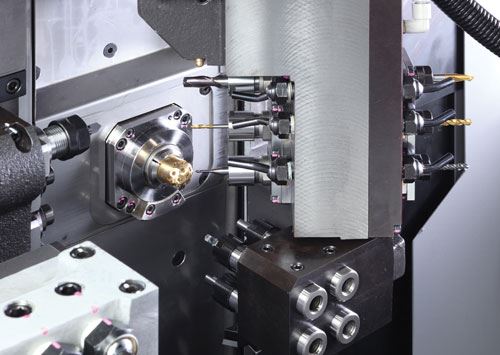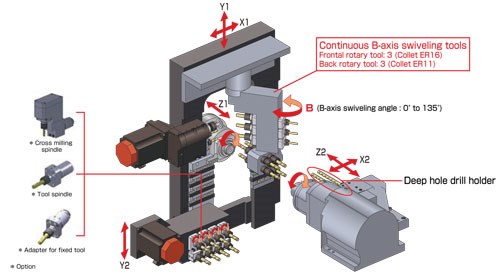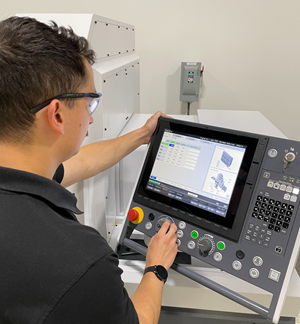Swiss-Type Sculpting Serves Complex Parts Complete
With capability for continuous cutting using a swiveling B axis tool post, this Swiss-type lathe enables users to machine complex, sculpted geometry without moving parts to another machine.
Share





The S207's capability for continuous machining reduces the need for secondary operations or reconfiguring the work zone during production of complex-geometry parts.
Considering how far Swiss-type lathes have evolved from the first models adopted to complement cam-operated screw machines, one could argue that the term “lathe” is a misnomer. With synchronized sub-spindles, live tooling, attachments for thread whirling and broaching, and other such developments pushing this platform beyond its initial limitations, the modern Swiss-type might be more aptly described as a variety of multitasking machining center.
Capability for continuous B-axis machining on Tsugami’s S207 is one example of a Swiss-type builder unveiling incremental—yet significant—developments that help customers manufacture increasingly complex parts without secondary operations. Available in the United States from REM Sales (Windsor, Connecticut), the 20-mm, gang-tooled machine enables users to produce complex, sculpted shapes on both the main and sub-spindles.
The machine accomplishes this via a servo-driven, B-axis tool post that can move vertically and swivel in a 135-degree range around the part being machined. Featuring a control resolution of 0.001 mm, the B axis works in conjunction with C-axis rotation to enable continuous cutting across virtually any area of the protruding barstock. In addition to machining highly contoured geometry, users can perform angled drilling and tapping without attachments. The B-axis tool post accommodates six 5,000-rpm live tools, three on the front for operations on barstock gripped in the main spindle and three on the back for operations on the sub-spindle.
Jeff Boulden, marketing manager at REM Sales, says demand for B-axis cutting capability on a Swiss-type is driven by a trend toward more complex-geometry parts in lower volumes. That calls for flexibility. “Shops are always looking for new ways to produce parts complete on one platform,” he notes. “In fact, we’ve found that anywhere between 18 and 25 percent of our customers who buy a Swiss-type in any given year have never used one before.”
In addition to producing complete components, the contouring B axis helps avoid the need to spend an inordinate amount of time reconfiguring the tool zone to accommodate a different part or particular machined feature. The capability is especially useful in the medical industry, where the increasing prevalence of sculpted, low-volume parts is particularly pronounced, Mr. Boulden adds. Medical shops can also benefit from the ability to seamlessly incorporate attachments for thread whirling, broaching and other specialty operations into the B-axis tool post.
He is quick to point out, however, that continuous B-axis cutting isn’t the only feature of the S207 that adds flexibility. The machine also comes with a conversion kit that enables users to remove the guide bushing and operate it like a fixed-headstock lathe. In addition to providing a more effective means of producing parts with length-to-diameter ratios of less than about 3:1, this enables users to perform separate roughing and finishing operations, as opposed to taking a full-depth cut. It also eliminates the need to use expensive, ground barstock. Costs are further reduced because without a guide bushing, the machine can access more of the bar and leave shorter remnants. Mr. Boulden says the S207 can be fully converted to “chucker mode” in less than half an hour.
Like many Tsugami models, the S207 also features modular tooling, which enables users to quickly move tools from one position to another according to their individual application requirements. Each toolholder is secured by four socket-head cap screws and features an identical, rectangular tang that mates with the drive shaft housing unit. In a matter of minutes, an operator can move a live spindle to a different location, replace face-oriented live tools with cross tools, convert a tool position from live to static (or vice versa), and so on.
However, Mr. Boulden points out that not all of the tool posts are modular, only those for which this capability is beneficial. For example, specific cross, face or other specialty tooling is not necessary on the swiveling B axis, which replaces what would otherwise be the tool post for the main spindle. Nonetheless, the orientation of the B axis somewhat limits its motion around parts gripped in the subspindle compared to the main spindle, so the traditional back tool post is still used to access some areas of workpieces gripped there. As such, the ability to quickly change those tools helps users adjust to new job requirements that much faster.
Related Content
How to Meet Aerospace’s Material Challenges and More at IMTS
Succeeding in aerospace manufacturing requires high-performing processes paired with high-performance machine tools. IMTS can help you find both.
Read MoreSwiss-Type Control Uses CNC Data to Improve Efficiency
Advanced controls for Swiss-type CNC lathes uses machine data to prevent tool collisions, saving setup time and scrap costs.
Read MoreIndustry Analysis: Machining Semiconductor Components
With many machine shops anticipating long-term growth in demand from the semiconductor industry, it is worth the time to heed the advice of manufacturers who have already been servicing this end-market for years.
Read MoreIntegration, Automation and Green Tech Highlight JIMTOF 2022
Known as one of the largest machine tool trade shows in the world, the Japan International Machine Tool Fair (JIMTOF) has a reputation for being a machining technology show more than a machine tool sales event. And this year’s show in Tokyo — the first in-person Japanese machine tool trade show in four years — did not disappoint.
Read MoreRead Next
Setting Up the Building Blocks for a Digital Factory
Woodward Inc. spent over a year developing an API to connect machines to its digital factory. Caron Engineering’s MiConnect has cut most of this process while also granting the shop greater access to machine information.
Read MoreBuilding Out a Foundation for Student Machinists
Autodesk and Haas have teamed up to produce an introductory course for students that covers the basics of CAD, CAM and CNC while providing them with a portfolio part.
Read MoreRegistration Now Open for the Precision Machining Technology Show (PMTS) 2025
The precision machining industry’s premier event returns to Cleveland, OH, April 1-3.
Read More
































